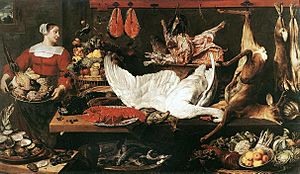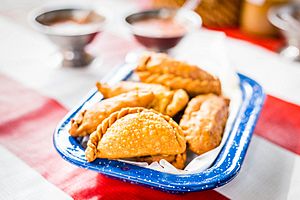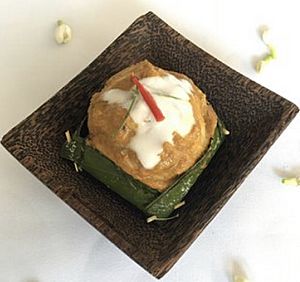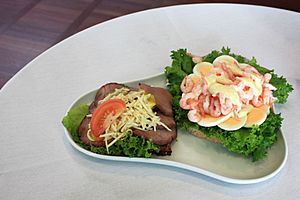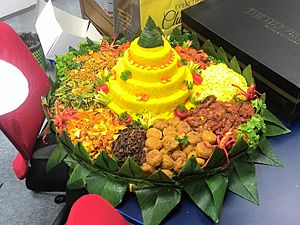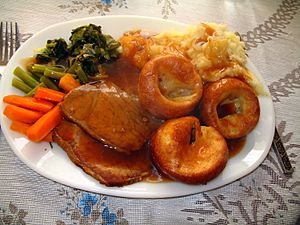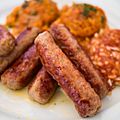National dish facts for kids
A national dish is a special food strongly linked to a certain country. Think of it as a country's food symbol! A dish can become a national dish for a few reasons:
- It's a staple food, meaning it's made from ingredients found locally. People prepare it in a unique way. For example, fruits de mer (seafood platters) are popular along the French coast.
- It uses a special ingredient grown only in that country. An example is paprika from the European Pyrenees mountains.
- It's part of a festive tradition or cultural heritage. This could be barbecues at summer camp or fondue at dinner parties. It can also be part of a religious practice, like Korban Pesach or Iftar meals.
- The country itself has promoted it as a national dish. For instance, fondue was promoted as Switzerland's national dish by the Swiss Cheese Union in the 1930s.
National dishes are a big part of a country's identity. In the past, countries would create their own special foods to show how they were different from other nations.
According to Zilkia Janer, a teacher from Hofstra University, it's hard to pick just one national dish for countries like Mexico, China, or India. This is because they have many different groups of people, cultures, and foods. Also, because national dishes are so important to a country's identity, choosing one can sometimes cause strong feelings or even disagreements!
Contents
Latin American National Dishes
In Latin America, many dishes are called "plato nacional" (national dish). But often, the same recipes are found in different countries with only small changes. For example, ceviche is popular in Peru and Ecuador. A thin cut of beef called matambre is almost a national dish in Paraguay.
Stews made with meat, plantains, and root vegetables are national dishes in several countries in Central America, South America, and the Caribbean. Colombia has ajiaco. The sancocho is popular in the Dominican Republic, Colombia, and Panama.
Janer (2008) points out that many countries sharing the same "national dish" makes us wonder if every country truly has a unique one. She says that food traditions often cross country borders.
People from Latin American countries who live in North America often feel a stronger connection to their "plato nacional." In their home countries, these dishes are usually eaten by people in rural areas, not always by city dwellers. But for those living abroad, these dishes help them keep their national identity and feel connected to their homeland. They proudly serve these foods at home and in restaurants. By celebrating their national dish, these communities can resist pressure to blend into one big group, like "Latino" or "Hispanic American."
A Taste of National Dishes Around the World
This is not a complete list of all national dishes. It shows some foods that are often thought of as national dishes.
A
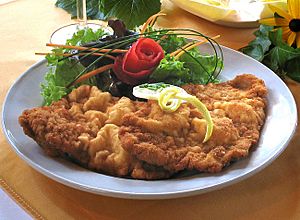
- Afghanistan: Kabuli palaw
- Albania: Tavë kosi, Flia
- Algeria: Couscous
- Andorra: Escudella i carn d'olla
- Angola: Moamba de galinha
- Argentina: Asado, empanada, matambre, Locro
- Armenia: Harisa
- Australia: Roast lamb, meat pie, pavlova, Vegemite on toast
- Austria: Wiener schnitzel
- Azerbaijan: Dolma
B
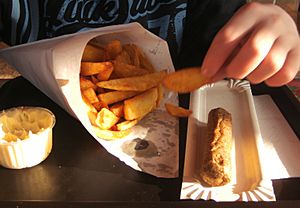
- Bahamas: Crack conch with peas and rice
- Bahrain: Kabsa
- Bangladesh: Rice and fish (especially ilish)
- Barbados: Cou-cou and flying fish
- Belarus: Draniki
- Belgium: Frites (with mussels or steak), carbonade flamande, Waterzooi, chocolate mousse
- Bhutan: Ema datshi
- Bolivia: Salteñas
- Bosnia and Herzegovina: Bosnian pot, Ćevapi
- Botswana: Seswaa
- Brazil: Feijoada
- Brunei: Ambuyat
- Bulgaria: Shopska salad
- Burundi: Boko Boko
C
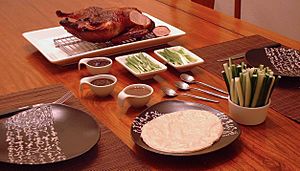
- Cambodia: Fish amok, num banhchok, samlar kako
- Cameroon: Ndolé
- Canada: Poutine, Kraft Dinner, Nanaimo bar, Butter tarts
- Chile: Empanada, Pastel de choclo
- China: Peking duck, luosifen, crayfish Hot pot, dumpling, malaxiangguo, Dim sum, Kaolengmian, Tanghulu
- Colombia: Ajiaco, arepa Bandeja paisa
- Comoros: Langouste a la vanille (Vanilla Lobster)
- Democratic Republic of the Congo: Poulet à la Moambé
- Republic of the Congo: Poulet Moambé
- Cornwall: Cornish pasty
- Costa Rica: Casado, Chifrijo (pork with beans, white rice, and pico de gallo), Gallo Pinto, Olla de Carne
- Croatia: Zagorski štrukli
- Cuba: Ropa vieja
- Cyprus: Souvla, Kleftiko, Trachanás
- Czech Republic: Vepřo-knedlo-zelo (Roast pork with dumplings and sauerkraut)
D
- Denmark: Stegt Flæsk, Smørrebrød
- Dominica: Mountain chicken (historical), Callaloo
- Dominican Republic: La bandera (rice, beans and meat)
E
- Ecuador: Encebollado, Guatitas, Fanesca
- Egypt: Ful medames, kushari, molokhiya, taʿamiya
- El Salvador: Pupusa
- Eritrea: Zigini with injera
- Estonia: Kama
- Ethiopia: Doro wat with injera
F
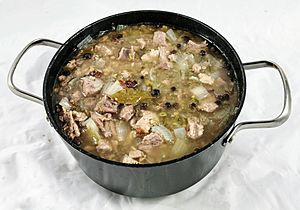
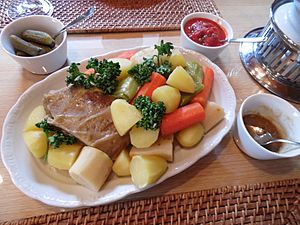
- Fiji: Fiji Kokoda (Fijian Ceviche)
- Finland: rye bread Lohikeitto
- France: Pot-au-feu, Beef bourguignon, Blanquette de veau, Steak frites, Baguette, Crêpe, Crème caramel, Poulet au pot (historical)
G
- Gabon: Poulet Nyembwe
- The Gambia: Domoda
- Georgia: Khachapuri
- Germany: Schnitzel, Schweinshaxe, Bratwurst, Sauerbraten, Döner kebab, Currywurst, Eisbein with sauerkraut
- Greece: Horiatiki, Moussaka, Fasolada Souvlaki, Gyros, Magiritsa, Kokoretsi
- Grenada: Oil down
- Guatemala: Pepián
- Guyana: Pepperpot and Chicken curry
H
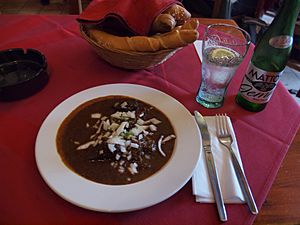
- Haiti: Griot, Soup joumou
- Hungary: Gulyás
- Honduras: Baleada
I
- Iceland: Lamb, Hákarl
- India: India has many different cultures and foods. So, it does not have one specific national dish. Instead, different regions have their own typical dishes.
- Indonesia: Nasi goreng, Tumpeng, Satay, Soto, Rendang, Gado gado
- Iran: Abgoosht, Chelo kabab, Ghormeh sabzi Fesenjan
- Iraq: Masgouf
- Ireland: Breakfast roll, Irish stew
- Israel: Falafel (in pita), Israeli salad, Shakshouka, Meorav Yerushalmi
- Italy: Pasta, pizza, risotto
- Ivory Coast: Atcheke
J
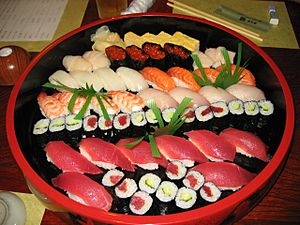
- Jamaica: Ackee and Saltfish, Jerk chicken
- Japan: Sushi, Japanese curry, Ramen, Tempura, Wagashi
- Jordan: Mansaf
K
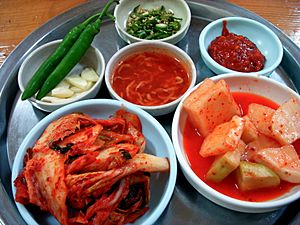
- Kazakhstan: Beshbarmak
- Kenya: Ugali with sukuma wiki, Githeri, chapati, nyama choma
- Korea, North: Raengmyŏn, kimchi
- Korea, South: Kimchi, Bulgogi, Bibimbap, Jajangmyeon, Bingsu
- Kosovo: Flia
- Kyrgyzstan: Beshbarmak
L
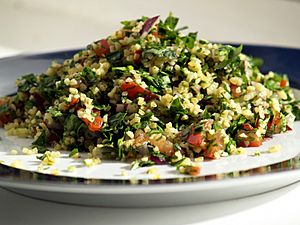
- Laos: Larb/Laap, sticky rice, Tam Mak Hoong
- Latvia: Layered rye bread, sklandrausis, Jāņi cheese
- Lebanon: Kibbeh, Tabbouleh
- Lithuania: Cepelinai, Šaltibarščiai
- Liechtenstein: Käsknöpfle
- Luxembourg: Judd mat Gaardebounen
M
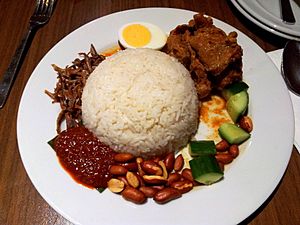
- Madagascar: Romazava
- Malawi: Chambo with nshima
- Malaysia: Nasi lemak, Satay
- Malta: Stuffat tal-fenek
- Mauritius: Dholl puri (flatbread stuffed with lentils)
- Mexico: Taco, Mole poblano, Chiles en nogada
- Monaco: Barbagiuan
- Montenegro: Njeguški pršut
- Morocco: Couscous, Tagine
- Myanmar: Mohinga, Lahpet thoke
N
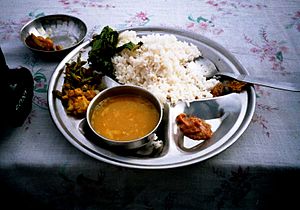
- Nepal: Dal bhat, Momo cha
- Netherlands: Stamppot, soused herring with onion and pickles
- New Zealand: Meat pie, bacon and egg pie, lamb, Pavlova
- Nicaragua: Gallo Pinto, Nacatamal, Vigorón
- Niger: Dambou
- Nigeria: Tuwo shinkafa, Jollof rice, Pounded Yam and Egusi soup
- North Macedonia: Tavče Gravče, Šopska Salata
- Norway: Fårikål
O
- Oman: Shuwa
P
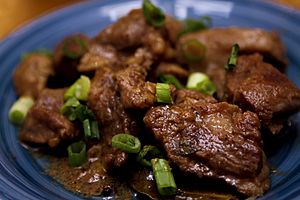
- Pakistan: Biryani, Nihari, Gulab jamun
- Palestine: Maqluba, Musakhan, falafel
- Panama: Sancocho
- Peru: Ceviche
- Philippines: Adobo, Sinigang, Sisig, Pancit, Halo-halo
- Poland: Bigos, Pierogi, Kotlet schabowy
- Portugal: Bacalhau, Caldo verde, cozido à portuguesa, Pastel de Belem, Sardinha Assada (Grilled Sardines)
- Puerto Rico: Arroz con gandules, Mofongo
Q
- Qatar: Machboos
R
- Romania: Mămăligă, Sarmale, Mici
- Russia: Borscht, Shchi, Kasha, Pelmeni, Pirozhki, Bliny, Oladyi, Sour cabbage, Bublik, Baranki, Karavai, Vareniki, Rassolnik, Pryanik
S
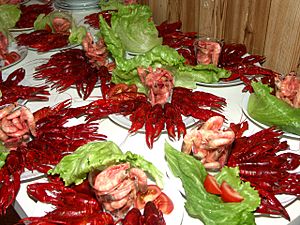
- Saudi Arabia: Kabsa, Saleeg
- Senegal: Thieboudienne
- Serbia: Ćevapčići, Pljeskavica, Gibanica (pastry), Karađorđeva steak, Sarma
- Singapore: Chilli crab, Hainanese chicken rice, Hokkien mee
- Slovakia: Bryndzové halušky
- Slovenia: Buckwheat dumplings (especially štruklji), Idrijski žlikrofi
- Somalia: Bariis Iskukaris
- South Africa: Bobotie
- Spain: Tortilla de patatas
- Catalonia: Pa amb tomaquet
- Galicia: Polbo á feira
- Valencia: Paella
- Sri Lanka: Rice and curry, Kottu
- Suriname: Pom
- Sweden: Köttbullar, Kräftskiva, Surströmming, Ostkaka
- Switzerland: Cervelat, Fondue, Muesli, Raclette, Rösti, Zürcher Geschnetzeltes
- Syria: Kibbeh
T
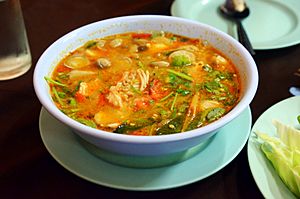
- Taiwan: Beef noodle soup Minced pork rice
- Tajikistan: Osh Palov, Qurutob
- Tanzania: Chipsi mayai
- Thailand: Pad Thai, Tom yum, Som tam
- Trinidad and Tobago: Callaloo, Doubles, Pelau
- Tobago: Curry Crab and Dumplings
- Tunisia: Kosksi, Brik/Bric
- Turkey: Kuru fasulye with pilaf/pilau, Kebap, Baklava, Simit
U
- Uganda: Matooke
- Ukraine: Borscht, Varenyky
- United Arab Emirates: Harees
- United Kingdom: Fish and chips, Chicken tikka masala, Full breakfast (regional variations)
- England: Sunday roast (especially roast beef), pudding (especially Christmas plum pudding)
- Northern Ireland: Ulster fry
- Scotland: Haggis
- Wales: Cawl
- United States: There is no official national food. Many authors name dishes like apple pie, hamburger, hot dog, turkey, mashed potatoes and gravy.
- Uruguay: Chivito
- Uzbekistan: Osh
V
- Vanuatu: Laplap
- Venezuela: Pabellón criollo
- Vietnam: Bánh chưng, Bánh giầy
Y
- Yemen: Saltah
Z
Images for kids
-
Chelo kabab, a national dish of Iran
-
Ćevapčići, a national dish in several Balkan states
-
Couscous, a national dish of Morocco, Algeria and Tunisia
-
Hainanese chicken rice, a national dish of Singapore
-
Phở - Vietnamese noodle soup, a Vietnamese national dish
-
Ndolé from Cameroon
-
Russian pirozhki
-
Poutine, a national dish of Canada
-
Pilaf (O'sh), a national dish in the cuisines of Central Asia
-
Pierogi ruskie, dumplings from Kresy, a national dish of Poland.
-
Thieboudienne, Senegal's national meal
-
Ukrainian borscht
National Drinks
Just like food, many countries have a special drink that is strongly linked to them. This "national drink" is also part of their identity. National drinks can be alcoholic or non-alcoholic.
An alcoholic national drink might be a specific type of alcohol, like whiskey in Ireland. More often, it's a mixed drink (like caipirinhas in Brazil) or a beer or wine. Non-alcoholic national drinks include tea for China, Coca-Cola for the US, lassis for India, mate for Uruguay, and kompot for Eastern European nations.
See also
 In Spanish: Plato nacional para niños
In Spanish: Plato nacional para niños


